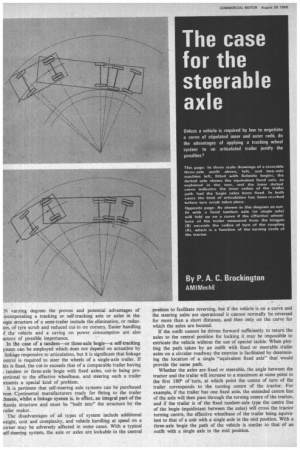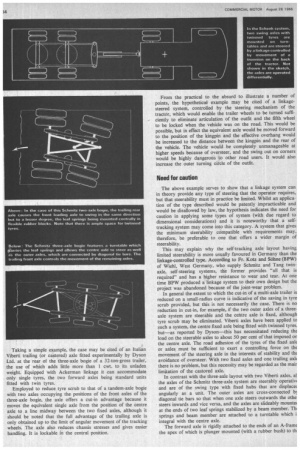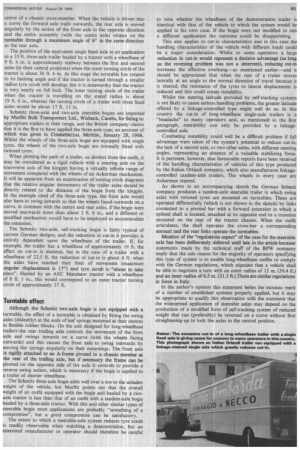The case for the steerable axle
Page 64

Page 65

Page 66

Page 67

If you've noticed an error in this article please click here to report it so we can fix it.
By P. A. C. Brockington
AMIMechE
N varying degrees the proven and potential advantages of .incorporating a tracking or self-tracking axle or axles in the .ogie structure of a semi-trailer include the elimination, or reducion, of tyre scrub and reduced cut-in on corners. Easier handling rf the vehicle and a saving on power consumption are also actors of possible importance.
In the case of a tandem—or three-axle boEie—a self-tracking ystem can be employed which does not depend on actuation by linkage responsive to articulation, but it is significant that linkage ontrol is required to steer the wheels of a single-axle trailer. If his is fixed, the cut-in exceeds that of a comparable trailer having tandem or three-axle bogie with fixed axles, cut-in being pro>ortional to the effective wheelbase, and steering such a trailer )resents a special kind of problem.
It is pertinent that self-steering axle systems can be purchased 'rom Continental manufacturers ready for fitting to the trailer .;hassis,' whilst a linkage system is, in effect, an integral part of the :hassis structure and must be "built into" the structure by the railer maker.
The disadvantages of all types of system include additional veight, cost and complexity, and vehicle handling at speed on a orner may be adversely affected in some cases. With a typical ;elf-steering system, the axle or axles are lockable in the central position to facilitate reversing, but if the vehicle is on a curve and the steering axles are operational it cannot normally be reversed for more than a short distance, and then only on the curve for which the axles are located.
If the outfit cannot be driven forward sufficiently to return the axles to the central position for locking it may be impossible -to extricate the vehicle without the use of special tackle. When plotting the path taken by an outfit with fixed or steerable trailer axles on a circular roadway the exercise is facilitated by determining the location of a single "equivalent fixed axle" that would provide the same path.
Whether the axles are fixed or steerable, the angle between the tractor and the trailer will increase to a maximum at some point in the first 180° of turn, at which point the centre of turn of the trailer corresponds to the turning centre of the tractor. For example, if the trailer has one fixed axle, the extended centre line of the axle will then pass through the turning centre of the tractor, and if the trailer is of the fixed tandem-axle type the centre line of the bogie (equidistant between the axles) will cross the tractor turning centre, the effective wheelbase of the trailer being equivalent to that of a unit with a single axle in the mid position. With a three-axle bogie the path of the vehicle is similar to that of an outfit with a single axle in the mid position.
Before dealing with steerable axles it is important to note that t is geometrically impossible for the extended centre line of a ingle fixed axle or of a fixed bogie to lie on the turning centre of he tractor if the distance between the kingpin of the trailer and his centre line exceeds the radius of turn of the tractor as neasured from the kingpin. In the event,the outfit folds up completely, the angle between the tractor and trailer being reduced to ,0° when the outfit is turned through 180', whilst additional novement of the tractor causes a further reduction in the angle progressively up to the limit of articulation. When the angle is educed to appreciably less than 90°, the tractor will push the railer backwards as well as pulling it sideways.
Whilst there is a number of maximum-length trailers in existnce to which this critical condition can apply, it would not do so nless the tractor were turning on full lock or close to full lock, ,ut if the regulations were amended to permit a maximum vehicle :ngth of 15m, the folding-up problem would become serious and any event cut-in would be a much greater nuisance than with ehicles conforming to the current regulations. A typical steerble-axle system reduces cut-in (and may also eliminate folding up) ecause it provides a reduction in the effective wheelbase of the 'ailer, the position of the equivalent single fixed axle being moved )rward.
Taking a simple example, the case may be cited of an Italian Viberti trailing (or castered) axle fitted experimentally by Dyson Ltd. at the rear of the three-axle bogie of a 32-ton-gross trailer, the use of which adds little more than I cwt. to its unladen weight. Equipped with Ackerman linkage it can accommodate only single tyres, the two forward axles being standard units fitted with twin tyres.
Employed to reduce tyre scrub to that of a tandem-axle bogie with two axles occupying the positions of the front axles of the three-axle bogie, the axle offers a cut-in advantage because it moves the equivalent single axle from the position of the centre axle to a line midway between the two fixed axles, although it should be noted that the full advantage of the trailing axle is only obtained up to the limit of angular movement of the tracking wheels. The axle also reduces chassis stresses and gives easier handling. It is lockable in the central position. From the practical to the absurd to illustrate a number of points, the hypothetical example may be cited of a linkagesteered system, controlled by the steering mechanism of the tractor, which would enable the trailer wheels to be turned sufficiently to eliminate articulation of the outfit and the fifth wheel to be locked when the vehicle was on the road. This would be possible, but in effect the equivalent axle would be moved forward to the position of the kingpin and the effective overhang would be increased to the distance between the kingpin and the rear of the vehicle. The vehicle would be completely unmanageable at higher speeds because of oversteer, and the swing out on corners would be highly dangerous to other road users. It would also increase the outer turning circle of the outfit.
Need for caution
The above example serves to show that a linkage system can in theory provide any type of steering that the operator requires, but that steerability must in practice be limited. Whilst an application of the type described would be patently impracticable and would be disallowed by law, the hypothesis indicates the need for caution in applying some types of system (with due regard to dimensional considerations) and it is noteworthy that a selftracking system may come into this category. A system that gives the minimum steerability compatible with requirements may, therefore, be preferable to one that offers a wider margin of steerability.
This may explain why the self-tracking axle layout having limited steerability is more usually favoured in Germany than the linkage-controlled type. According to Fr. Kotz and Sohne (BPW) of Wiehl, West Germany, who supply Schmitz and Tang twinaxle, self-steering systems, the former provides "all that is required" and has a higher resistance to wear and tear. At one time BPW produced a linkage system to their own design but the project was abandoned because of the joint-wear problem.
In general the extent to which the cut-in of a multi-axle trailer is reduced on a small-radius curve is indicative of the saving in tyre scrub provided, but this is not necessarily the case. There is no reduction in cut-in, for example, if the two outer axles of a threeaxle system are steerable and the centre axle is fixed, although tyre scrub may be eliminated. Viberti axles have been applied to such a system, the centre fixed axle being fitted with twinned tyres. but—as reported by Dyson—this has necessitated reducing the load on the steerable axles to about 50 per cent of that imposed on the centre axle. The road adhesion of the tyres of the fixed axle or axles must be sufficient to exert a controlling force on the movement of the steering axle in the interests of stability and the avoidance of oversteer. With two fixed axles and one trailing axle there is no problem, but this necessity may be regarded as the mak limitation of the castored axle.
In contrast with the three-axle layout with two Viberti axles, al the axles of the Schmitz three-axle system are steerably operative and are of the swing type with fixed hubs that are displace( angularly as a unit. The outer axles are cross-connected la-2 diagonal tie bars so that when one axle steers outwards the othe
• steers inwards and vice versa, and the axles are slideably mountec at the ends of two leaf springs stabilized by a beam member. Th, springs and beam member are attached to a turntable which i integral with the centre axle.
The forward axle is rigidly attached to the ends of an A-frame the apex of which is plunger mounted (with a rubber bush) to th
centre of a chassis cross-member. When the vehicle is driven into a curve the forward axle trails outwards, the rear axle is moved angularly by the action of the front axle in the opposite direction and the entire assembly (with the centre axle) rotates on the turntable through a maximum angle of 60 in the same direction as the rear axle.
The position of the equivalent single fixed axle in an application to a 33 ft. three-axle trailer hauled by a tractor with a wheelbase of 9 ft. 6 in. is approximately midway between the first and second axles (in their central positions) when the outer turning circle of the tractor is about 36 ft. 6 in. At this stage the turntable has rotated to its limiting angle and if the tractor is turned through a smaller radius tyre scrub will develop, but it is noteworthy that the tractor is very nearly on full lock. The inner turning circle of the trailer when the tractor is travelling on the stated radius is about 19 ft. 6 in., whereas the turning circle of a trailer with three fixed axles would be about 17 ft. 11 in.
Schmitz three-axle and two-axle steerable bogies are imported by Murfitt Bulk Transporters Ltd., Wisbech, Cambs, for fitting to appropriate trailers in their range, and the British company claims that it is the first to have applied the three-axle type, an account of
which was given in COMMERCIAL MOTOR, January 28, 1966. Whilst the wheels of the three-axle bogie are equipped with single tyres, the wheels of the two-axle bogie are normally fitted with twinned tyres.
When plotting the path of a trailer, as distinct from the outfit, it may be considered as a rigid vehicle with a steering axle on the transverse axis of the kingpin having a virtually infinite range of movement compared with the wheels of an Ackerman mechanism. It will be apparent from an examination of turning-circle diagrams that the relative angular movements of the trailer axles should be directly related to the distance of the bogie from the kingpin. In the example cited of the three-axle type, the front axle would also have to swing inwards so that the wheels faced outwards on a curve, in common with the centre and rear axles, if the bogie were moved rearwards more than about 2 ft. 6 in., and a different or modified mechanism would have to be employed to accommodate the extension.
The Schmitz two-axle, self-tracking bogie is fairly typical of current German designs, and the reduction in cut-in it provides is entirely dependent upon the wheelbase of the trailer. If, for example, the trailer has a wheelbase of approximately 19 ft. the effect on cut-in is minimal, but in the case of a trailer with a wheelbase of 22.5 ft. the reduction of cut-in is pout 4 ft. when the axles have reached their limit of movement (maximum angular displacement is 17°) and tyre scrub is "about to take place". Hauled by an AEC Mandator tractor with a wheelbase of 8 ft. 1 in., this would correspond to an outer tractor turning circle of approximately 37 ft.
Turntable effect
Although the Schmitz two-axle, bogie is not equipped with a turntable, the effect of a turntable is obtained by fitting the swing axles (slideably) at the ends of leaf springs mounted at their centres in flexible rubber blocks. On the unit designed for long-wheelbase trailers the rear trailing axle controls the movement Of the front axle and swings inwards on a curve (with the wheels facing outwards) and this causes the front axle to swing outwards by moving the springs angularly on their mountings. The front axle is rigidly attached to an A-frame pivoted to a chassis member at the rear of the trailing axle, but if necessary the frame can be pivoted on the opposite side of the axle it controls to provide a reverse swing action, which is necessary if the bogie is applied to a trailer of shorter wheelbase.
The Schmitz three-axle bogie adds well over a ton to the unladen weight of the vehicle, but Murfitt points out that the overall weight of an outfit equipped with the bogie and hauled by a twoaxle tractor is less than that of an outfit with a tandem-axle bogie hauled by a three-axle tractor. With this and other similar types of steerable bogie most applications are probably "something of a compromise", but a good compromise can be satisfactory.
The extent to which a steerable-axle system reduces tyre scrub is readily observable when watching a demonstration, but an interested manufacturer or operator should therefore be careful to note whether the wheelbase of the demonstration trailer is identical with that of the vehicle to which the system would be applied in his own case. If the bogie were not modified to suit a different application the outcome could be disappointing.
This also applies to cut-in characteristics and in this case the 'handling characteristics of the vehicle with different loads could be a major consideration. Whilst to some operators a large reduction in cut-in would represent a decisive advantage (as long as the reversing problem was not a deterrent), reducing cut-in increases the effective overhang—as mentioned earlier and it should be appreciated that when the rear of a trailer moves laterally at an angle to the normal direction of travel because it is steered, the 'resistance of the tyres to lateral displacement is reduced and this could create instability.
Whilst the steering latitude provided by self-tracking systems is not likely to cause serious handling problems, the greater latitude offered by a linkage-controlled type might well do sq. In this country the cut-in of long-wheelbase single-axle trailers is a "headache" to many operators and, as mentioned in the first paragraph, steerability can only be provided by a linkagecontrolled axle.
Combating instability could well be a. difficult problem if full advantage were taken of the system's potential to reduce cut-in, the lack of a second axle, or two other axles, with different steering angles, representing an absence of a valuable stabilizing force. It is pertinent, however, that favourable reports have been received of the handling characteristics of vehicles of this type produced by the Italian Orlandi company, which also manufactures linkagecontrolled tandem-aide trailers. The wheels in every case are Ackerman steered.
As shown in an accompanying sketch the German Schenk company produces a tandem-axle steerable trailer in which swing axles with twinned tyres are mounted on turntables. These are operated differentially (which is not shown in the sketch) by links connected to a pivoted bar with a forward extension in which a splined shaft is located, attached at its opposite end to a trunnion mounted on the rear of the tractor chassis. When the outfit articulates, the shaft operates the cross-bar a corresponding amount and the rear links operate the turntables.
Mention of the "regulations aspect" of the case for the steerable axle has been deliberately deferred until late in the article because statements made by the technical staff of the BPW company imply that the sole reason for the majority of operators specifying this type of system is to enable long-wheelbase outfits to comply with the German regulations, which stipulate that a vehicle shall be able to negotiate a turn with an outer radius of 12 m. (39.4 ft.) and an inner radius of 6.5 in. (21.3 ft.).There are similar regulations in force in Italy.
In the author's opinion this statement belies the intrinsic merit of a number of established systems properly applied, but it may be appropriate to qualify this observation with the comment that the widespread application of steerable axles may depend on the production of a modified form of self-tracking system of reduced weight that can (preferably) be reversed on a curve without first straightening-up to lock the axles in the central position.




















































































































